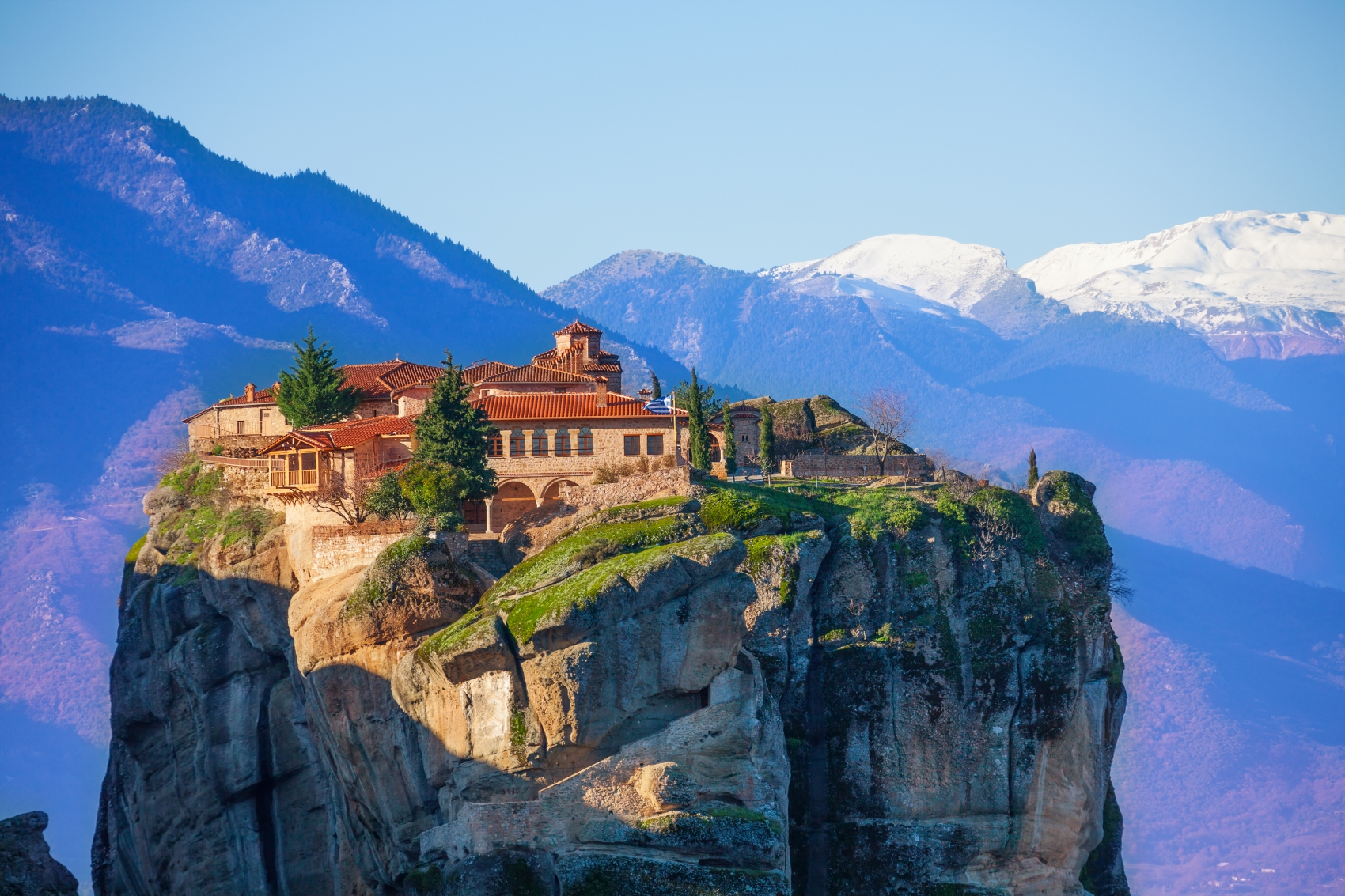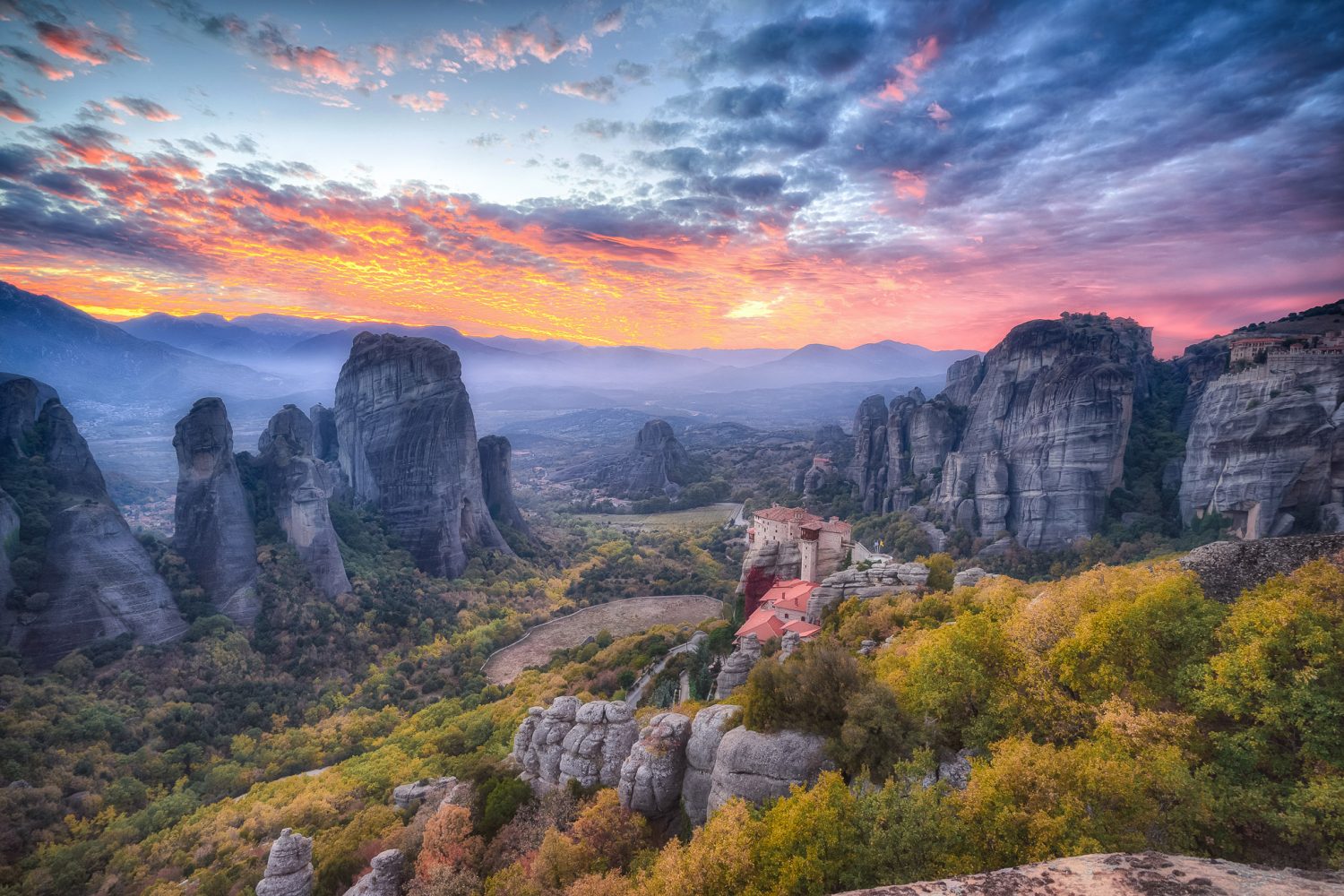



Meteora is a UNESCO World Heritage site in Greece, featuring a collection of Eastern Orthodox monasteries perched atop towering rock formations, known for their unique geological features and spiritual significance.
✅ Best Time to Visit:
Spring (April-May): Blooming landscapes, mild weather, and fewer crowds.
Fall (September-October): Pleasant temperatures and stunning autumn foliage.
Avoid: Summer (July-August) due to heat and peak tourist traffic. Winter can be cold but offers a mystical, fog-covered view.
🚗 How to Get There:
From Athens (Approx. 360 km / 224 miles):
By Car: 4-5 hours via the E75 highway to Kalambaka (the nearest town).
By Train: Direct train from Athens to Kalambaka (about 4.5-5 hours).
By Bus: Take a bus from Athens to Trikala, then a local bus to Kalambaka.
From Thessaloniki (Approx. 230 km / 143 miles):
By Car: About 3 hours via Egnatia Odos Highway (A2).
By Train: Direct train to Kalambaka (about 3 hours).
By Bus: Bus to Trikala, then connect to Kalambaka.
Monasteries of Meteora (UNESCO World Heritage Site):
Great Meteoron Monastery – The largest and most famous, with a rich history and museum.
Varlaam Monastery – Known for its impressive frescoes and historic library.
Rousanou Monastery – Smaller but offers breathtaking views and easier access.
Holy Trinity Monastery – Featured in the James Bond movie For Your Eyes Only.
St. Nicholas Anapausas – Compact, with stunning Byzantine art.
St. Stephen’s Monastery – Easily accessible and known for its peaceful gardens.
Kalambaka Town: Gateway to Meteora, with charming cafes, shops, and local culture.
Theopetra Cave: An archaeological site with evidence of human habitation dating back 130,000 years.
Monastery Hopping: Explore all six active monasteries perched on the cliffs.
Hiking & Rock Climbing: Follow scenic trails or climb the famous limestone pillars.
Sunset Tours: Witness breathtaking sunsets over the Meteora rocks.
Photography: Capture the stunning monasteries rising above the mist.
Cultural Festivals: Attend the Meteora Byzantine Music Festival (summer).
Local Handicrafts: Explore workshops offering religious icons and traditional pottery.
Luxury:
Grand Meteora Hotel – Elegant stay with spa services and monastery views.
Divani Meteora Hotel – Upscale with a pool, spa, and mountain views.
Mid-Range:
Dellas Boutique Hotel – Charming with modern comforts near Kastraki village.
Hotel Kastraki – Cozy stay at the base of the cliffs.
Budget-Friendly:
Guesthouse Arsenis – Traditional, family-run guesthouse with a warm atmosphere.
Tsikeli Hotel – Affordable with simple, clean rooms and great views.
✅ Local Specialties:
Kontosouvli: Slow-roasted pork on a spit.
Moussaka: Layers of eggplant, minced meat, and béchamel.
Trahana Soup: A comforting dish made from fermented wheat and yogurt.
Spanakopita: Spinach and feta pie in flaky phyllo dough.
Tsipouro: Strong local spirit similar to grappa.
🍴 Top Restaurants:
Meteoron Panorama: Offers local cuisine with panoramic views.
Taverna Gardenia: Cozy spot in Kastraki with homemade Greek dishes.
Archontariki: Authentic Greek taverna known for grilled meats and local wine.
Elias Garden: Peaceful setting with fresh, seasonal dishes.
Meteora is not only known for its breathtaking landscapes and towering monasteries but also for its rich cultural and spiritual heritage. This region blends ancient religious traditions, local customs, and a deep connection to nature.
Greek Orthodox Monasticism:
The Meteora monasteries are a center of Greek Orthodox Christianity, with a monastic tradition dating back to the 14th century.
Monks and nuns continue to live, pray, and preserve ancient rituals in the monasteries. Visitors are welcome but must respect the religious customs.
Icons and Frescoes:
The monasteries house Byzantine icons, frescoes, and manuscripts. These works of religious art depict biblical scenes and the lives of saints.
Icon painting is a living tradition in the region, with local artisans creating sacred images using age-old techniques.
Hospitality (Philoxenia):
Greek hospitality is warm and genuine. Locals are welcoming to visitors and often share stories about the region’s history.
Religious Festivals:
August 15th – Feast of the Assumption: Celebrated at St. Stephen’s Monastery, this major festival includes religious services, processions, and local feasts.
Holy Week (Easter): Meteora becomes especially spiritual during Easter with candlelit processions and midnight services.
Traditional Dress:
Older residents in nearby villages may still wear traditional Greek attire during religious and cultural festivals.
Handmade Religious Icons: Crafted by monks and local artisans, these are popular souvenirs.
Herbs & Teas: Wild herbs from Mount Koziakas are used in herbal teas and remedies.
Local Honey: Produced by beekeepers using ancient methods in the region’s wildflower meadows.
Textiles & Embroidery: Handwoven wool items and intricate embroidery are crafted in local workshops.
Traditional Greek Music: Folk music with instruments like the bouzouki and lyra is common during festivals.
Local Dances: Dances such as Syrtos and Kalamatianos are performed during celebrations, especially at weddings and religious holidays.
The Floating Monasteries: According to legend, the Meteora rocks were sent from heaven to provide a place for monks to pray in peace.
Hidden Treasures: During Ottoman rule, monks supposedly hid valuable manuscripts and relics in the caves and monasteries.